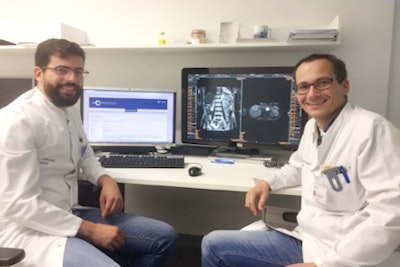
Structured reporting offers the prospect of speedier reporting throughput, but it also has major implications for epidemiology due to its capacity to store easily accessible data, notably numerical measurements, according to a German expert.
"There is so much more you can do with imaging data, other than providing a timely diagnosis," noted Dr. Daniel Pinto dos Santos, consultant abdominal and interventional radiologist at Cologne University Hospital. "All data generated by imaging could prove valuable."
 Without structured reporting, valuable imaging data are getting lost, warned Dr. Daniel Pinto dos Santos (left), pictured here with colleague Dr. Thorsten Persigehl. Image courtesy of Finn Drescher.
Without structured reporting, valuable imaging data are getting lost, warned Dr. Daniel Pinto dos Santos (left), pictured here with colleague Dr. Thorsten Persigehl. Image courtesy of Finn Drescher.In a presentation at the European Society of Medical Imaging Informatics (EuSoMII) meeting in Rotterdam, the Netherlands, on 18 November, he said structured reporting could prove revolutionary in artificial intelligence and quality control. For instance, by comparing MRI tumor stage with the pathology report after surgery, structured reporting systems can allow automatic assessment of accuracy in MRI. Furthermore, specialists can take data from structured reports to use as annotations when training algorithms.
"Instead of having to use Natural Language Processing (NLP) to extract your annotations from unstructured reports, you could simply take your structured data from clinical routine, and that should make it a lot easier to get larger numbers of useful annotated data," Pinto dos Santos told AuntMinnieEurope.com in an interview.
MRI for rectal cancer is a case in point. If rectal cancer is reported on in a structured manner that also allows for the data to be accessible, then distribution of tumor stage in patients could be easily calculated. At a broader level, accurate estimates of mean patient age, and other statistics such as incidence per year, could also be obtained.
A few mouse clicks away
Structured data, vital for optimizing both diagnostics and retrospective analysis, can be accessed in a few mouse clicks. However, relatively few imaging professionals attempt structured reporting, opting instead for free text, in part because vendors so far have failed to develop tools and platforms that would make structured reporting widely available and easy to implement.
"There are, as yet, no products with interoperable integration capacity available on the market," he said, adding that he hopes to replicate in Cologne his previous experiences of self-developed tools at Mainz University Hospital.
He urges radiologists to demand more structured reporting capacity from vendors, and to do more to convince vendors that these platforms are worth developing. He thinks now is the time for vendors and radiologists alike to get on board with product development.
While the clinical and wider benefits of structured reporting are tacitly accepted, there remains a gap between understanding the theory and routine clinical application, according to Pinto dos Santos.
Impact on practice
He hopes a pilot reporting platform developed at Mainz will herald a new era of structured reporting and have an impact on daily reporting practice. It is thought to be the first reporting platform that is fully compliant with Integrating the Healthcare Enterprise's specifications for Management of Radiology Report Templates (IHE MRT).
The platform developed by Pinto dos Santos and his colleagues is an open-source system that can import standardized templates from the Radiological Society of North America (RSNA) and other societies for reporting on specific clinical questions. So far, only the RSNA has provided freely available templates on www.radreport.org and open.radreport.org. The Mainz group has developed its templates mostly on its own, but it offers the possibility to import the RSNAs templates, he said.
 Together we can improve structured reporting, Pinto dos Santos said.
Together we can improve structured reporting, Pinto dos Santos said.The platform's capacity to integrate external data such as ultrasound exams into the structured report -- e.g., for questions about carotid artery stenosis -- can reduce the reporting work for the radiologist. Measurements of peak systolic blood-velocity performed on the ultrasound machine can be sent as DICOM standard report (DICOM SR) objects to the PACS, where the reporting platform can query them and insert the respective values into the corresponding fields in the report template. This means the user does not need to copy or dictate measurement values, but is presented with a prefilled template when it is time to report the exam. The system can integrate information from CT exams in a similar way.
"This system has the potential to make reporting faster and easier, and also helps obviate mistakes that might happen when dictating or copying values to a report," Pinto dos Santos said.
He estimated traditional reporting for carotid ultrasound takes somewhere around one to two minutes per exam, while structured reporting with automated incorporation of external data and automated calculation of stenosis can reduce the time spent by 50% to 75%.
RIS integration
The platform can be integrated with the radiology information system (RIS), so reports can be sent to and integrated into the radiology workflow. More recently, Pinto dos Santos has been working to integrate the platform into the RIS at Cologne.
While such structured reporting can help reduce reporter errors and speed up reporting, for wide-scale implementation, vendors will need to tighten integration and make systems look better and work even faster, he continued.
"We've proved that structured reporting is possible with comparatively little developmental work and investment, and we are now in the process of proving it is better than conventional reporting," Pinto dos Santos said, pointing to a necessary collaboration between radiologists and vendors in product development and integration into clinical routine. "Vendors need to build products that support the well-defined IHE structured reporting profile, and radiologists need to ask for this solution. Together we can improve structured reporting."



















